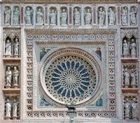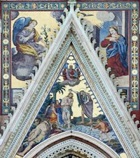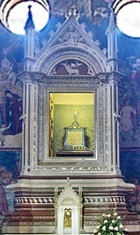Andrea di Cione di Arcangelo, usually called Orcagna, spent most of his life in his native Florence, although he acted as capomaestro of work on the Duomo of Orvieto for a period in 1359.
Duomo, Orvieto
Rose Window (1359)
Andrea Orcagna was responsible for the rose window in the
facade and the statues in niches to the sides of it.
Baptism of Christ (1360)
Andrea Orcagna and
Giovanni di Buccio di Leonardello collaborated on the cartoon for the Baptism of Christ in the gable over the left door
in the facade in 1360.
Nello da Roma completed the mosaic of the Annunciation to St Anna in 1362. The Opera del Duomo waited for a year before paying for these mosaics because there were concerns for their stability: in 1363,
Ugolino di Prete Ilario pronounced them "
perfectum, et bonum et pulchrum"(perfect and good and fair). These original mosaics no longer survive.
Tabernacle (1358-63)
This tabernacle on the altar of the
Cappella del Corporale was commissioned to house the
Sacro Corporale and its original reliquary. A certain
Nicolò da Siena was commissioned to design it in 1358, and it is usually assumed that Andrea Orcagna (who was
capomaestro at this time) directed the project. Fittings were commissioned in 1363, presumably to hold the finished tabernacle in place. A set of keys was commissioned for the tabernacle in 1366, together with a set of stairs, presumably to facilitate access to it.
The tabernacle has a relief of the Agnus Dei in the lunette, with a relief of Christ the Redeemer in the gable above. The gilded doors have images of the Virgin, St John the Baptist and angels.
The tabernacle still houses the Sacro Corporale, although now in the more portable reliquary that is still used in the annual procession.






